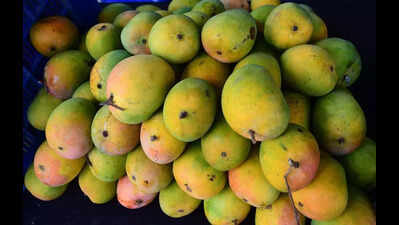Finding worms in mangoes? Blame it on recent climatic shifts | Bengaluru News

Bengaluru: Choosing delicious and quality mangoes from a fresh pile at the market could be a tricky business. But if you find worms in the king of fruits this summer, it may not be the fault of vendors but rather the result of changing climatic conditions affecting the mango crop, say horticulture experts. Unlike in previous years, fluctuating temperatures and sudden rainfall over the past couple of months have severely impacted mango production. The unusual increase in temperature and elevated soil moisture between Feb and April across mango-growing regions have resulted in greater pest infestation of the fruits.“The worms you find in fruit are the result of this infestation by fruit flies and thrips. But not all mangoes are infected by pests, only some arriving in the market in the middle and towards the end of the mango season,” explained CG Nagaraj, managing director of Karnataka State Mango Development and Marketing Corporation Ltd.While 2025 was expected to be a productive season for mangoes, climatic variations have turned it into an off-season with a notable decrease in yield. “Because of bounteous rainfall, there was delayed flowering this year. While it should flower in Dec-Jan normally, flowering was noticed in Jan-Feb because of physiological stress in the plants. During that time, the mercury levels rose abnormally up to 32-34C. This affected the pollination and setting of fruit,” Nagaraj said.The extreme temperature and early onset of summer showers created favourable conditions for thrips and fruit flies. A technical officer from the mango corporation explained: “Usually, their larvae are present in soil. As rain in summer increases humidity levels and moisture in soil, thrips come out and feed on fruits that are setting, and lay eggs in them. They wouldn’t even damage the fruit but pierce it at one point and lay eggs before disappearing.“The board has been working to control infestation by distributing pest traps and educating farmers on the methods to manage these pests. While many farmers have successfully controlled pests, the smaller and marginal ones have struggled, affecting the quality of their produce.Meanwhile, India Meteorological Department’s forecast of an early monsoon is expected to cause further damage to the crop, particularly affecting late mid-season and late-season varieties such as Malgova and Neelam. Strong winds have already impacted heavy fruit varieties such as Imam Pasand, Mallika, and Malgova.Despite these challenges, early mango varieties from Ramanagara and Bengaluru Rural districts have completed their market cycles. Mid-season and late mid-season varieties are currently available, marking the peak of mango season.However, an official from the mango corporation warned that because of early onset of monsoon, the mango season might end by the first week of June, whereas it typically extends throughout the month.
















